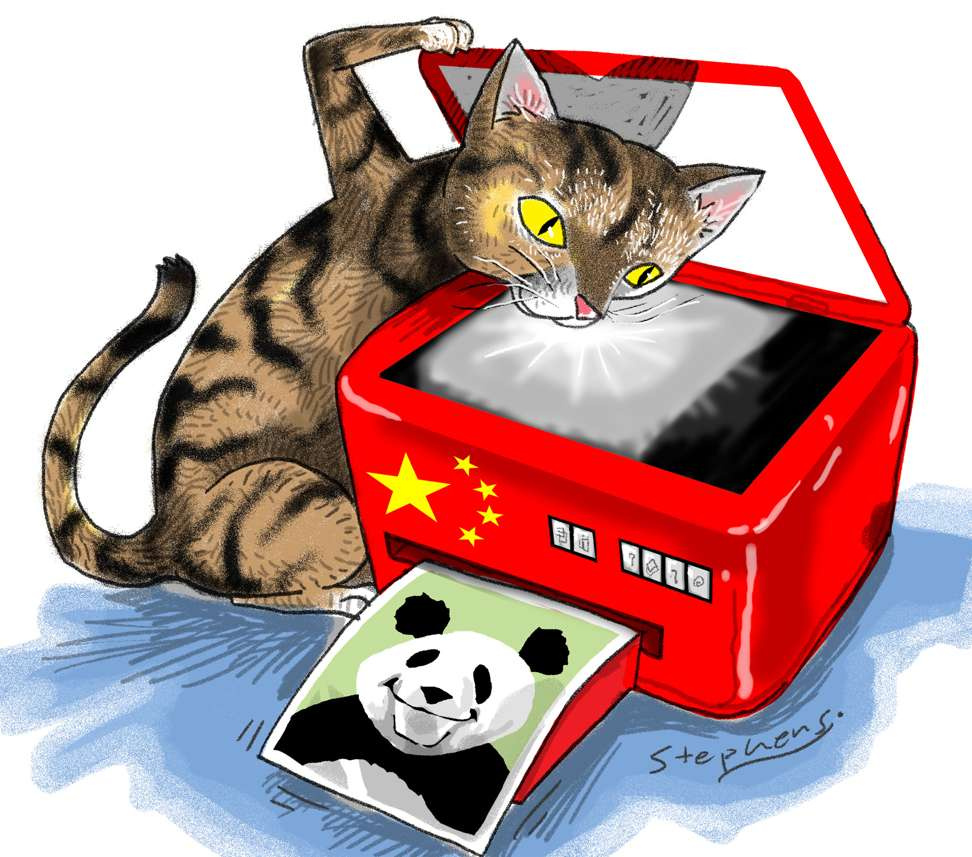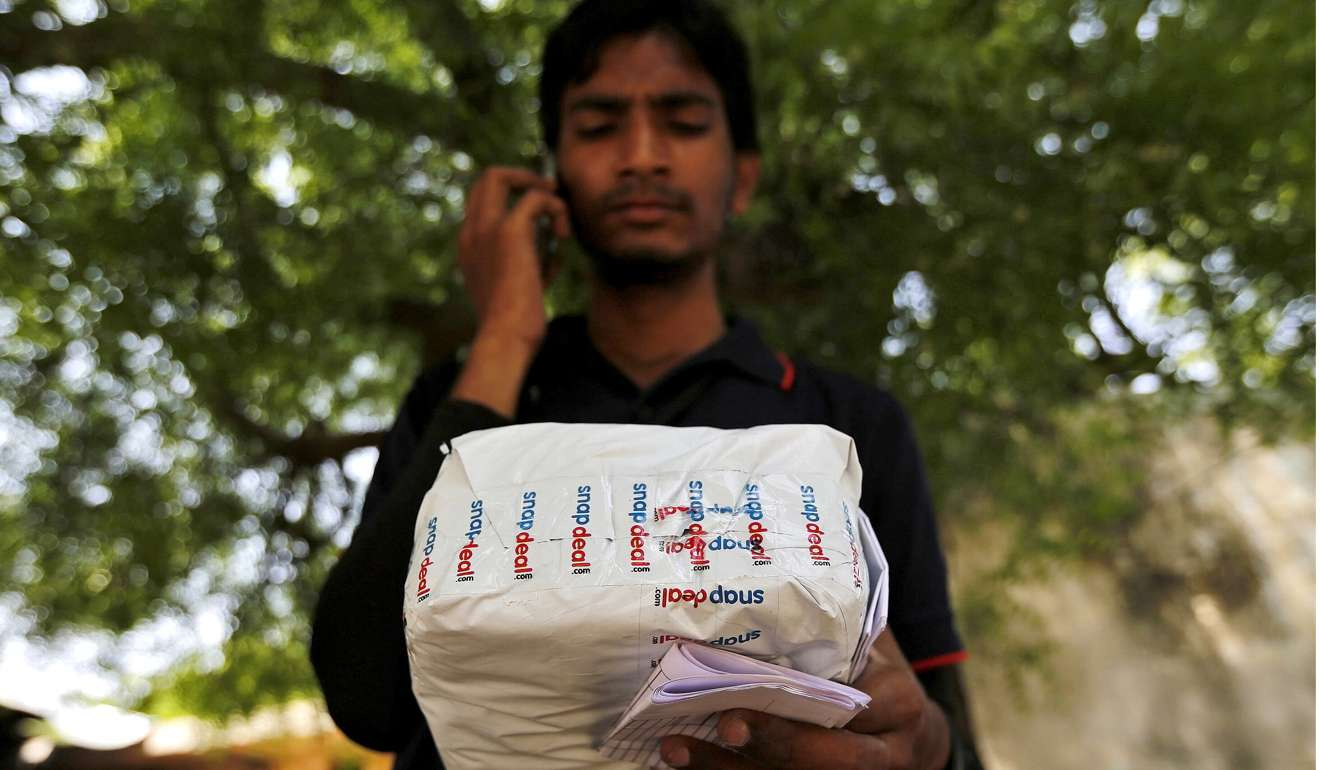Edward Tse and Mark Dzhervaszy claim that a country that was ridiculed earlier because of its inability to produce anything other than fakes today gives rise to leaders in innovation and becomes a role model for the rest.
 The cat is depicted as a cartoon because in English “imitators” are called “copycats”. The etymology of the term is unclear - cats usually do not show a tendency to imitation / approx. trans.
The cat is depicted as a cartoon because in English “imitators” are called “copycats”. The etymology of the term is unclear - cats usually do not show a tendency to imitation / approx. trans.For a long time, Chinese companies were known for copying reputable products, brands and business models from the West and adapting them to their market with minor changes. This phenomenon is known as "Sanzai", literally "mountain fortress" - this word was originally designated gangster formations in remote regions, not subordinate to the government. In today's slang, these are businesses based on fake or pirated products.
In recent decades, Sanzai have felt great in China, and have earned the country a reputation as a “nation of imitators.” Western media say that Chinese companies get a big head start for making copies thanks to the preferential policies of China and restrictions on entering the market, something like the Great Firewall on the Internet.
But a side effect of protectionism was the emergence of a unique ecosystem of innovations. Innovation in China - an evolutionary approach on a large scale - is different from innovation in the West, and they affect both emerging and emerging economies.
Sanzai is found among various products and services, but it is most pronounced in the Internet sector. Chinese Internet companies are often compared with their Western counterparts based on the similarity of business models. Baidu is considered “Chinese Google”, Alibaba is “Chinese eBay”, Xiaomi is “Chinese Apple”, etc.
In such comparisons, the context that gave China the foundation for the birth of such companies and their evolution is usually neglected. For example, although Alibaba adapted the eBay model at the beginning, it went through so many changes that today this business model can only be described as a combination of models from at least three Internet giants: Google, eBay and Amazon. The success of many Chinese companies in different sectors depends on their ability to evolve and adapt Western ideas for their home market. This form of evolution with incessant microinnovations affects the lives of hundreds of millions of people.
 Man with a mobile phone in Beijing
Man with a mobile phone in BeijingAnother example is Tencent, which launched WeChat in 2011, a simple instant messaging system on mobile phones, which gradually grew into a global super app that combines the features of models such as WhatsApp, Facebook, Instagram, Skype, Uber, Tinder, and others. Today, WeChat has 846 million users worldwide every month.
Mainly due to the success of WeChat, Tencent has expanded and engaged in other innovative enterprises in the field of social networking and mobile games. Tencent leads the world in terms of monetization of mobile applications. The latest developments of Facebook Messenger, WhatsApp and Kik Messenger explicitly copy the WeChat strategy and functionality.
In addition to Tencent, there are a lot of areas in which Chinese companies overtake the rest of the world, for example, Internet finance, new social networks, artificial intelligence, virtual reality, augmented reality and smart transportation. Justin Kahn, the founder of Twitch.tv, a US-based broadcasting platform to showcase games that Amazon then bought, said: “Just as everyone is interested in what’s happening in Silicon Valley, we also need to pay attention to innovations coming from China. You’ll see a lot of Chinese innovation trickling to the US. ”
For the first time, technological models of the West are challenged by Chinese models. And people begin to notice this development. At a technology conference in Beijing last year, Uber founder and CEO Traber Kalanick predicted that "in the next five years, more innovations, more inventions and more entrepreneurship will occur in Beijing in China than in Silicon Valley."
Last year, Baidu, Huawei, Tencent, Didi Chuxing, and Alibaba (which owns Hong Kong’s oldest English-language newspaper, The South China Morning Post) were among the “50 Smartest Companies” selected in the MIT's Technology Review technology blog, next to Tesla, Nvidia, SpaceX , Facebook and others. DJI and Ehang, two Chinese multicopter manufacturers, have become world leaders in the innovation of unmanned aerial vehicles.
In the post-Sanzai era, China will face the prosperity of business models and innovations. Some companies in the rest of the world are already starting to take a cue from the Chinese, especially in the technology sector. We call this phenomenon "reverse sanzai."
Tokopedia, the largest Indonesian e-commerce platform, is advertised as Indonesian Taobao. “I really like Jack Ma's strategic vision,” says William Tanuwijaya, the co-founder of Tokopedia, who took Alibaba’s business model as the basis for its development.
 An employee of the Indian online store Snapdeal calls the customer before delivery. Ahmedabad, India, 2015.
An employee of the Indian online store Snapdeal calls the customer before delivery. Ahmedabad, India, 2015.Snapdeal, which is called "Indian Alibaba" - is the country's largest online store. Prior to launch, Kunal Ball and its partner Rohit Bansal visited China in 2011 and noted that the Indian market is more like the Chinese than the American. They realized that the Alibaba platform strategy could solve India’s biggest problem: bringing together millions of small Indian brands and retailers.
The same thing happened in Nigeria, where the Konga.com e-commerce site was first launched as a local version of Amazon, and then turned into an “African Alibaba”. This trend is not limited to e-commerce. Indian entrepreneur Vijay Shekar Sharma, a fan of Jack Ma, built a model of his company Paytm in the image of Alibaba. His company, something like “Indian Alipay,” recently received funding from Ant Financial.
The bike rental system without base stations is a recent example of exporting Chinese innovation. The leading company, Mobike, has grown from zero to 23 Chinese cities in 10 months, and has processed 200 million trips since its launch in April 2016. Other similar companies, for example, oBike and LimeBike, have already appeared in Singapore and Silicon Valley, respectively.
In some cases, Chinese companies are entering international markets with strategic investments in foreign companies. For example, Alibaba has invested in Singapore's Lazada online store to make "South Asian Alibaba." Didi Chasing invested in Grab, the leading search site for travel companions in South Asia.
 Malaysian Prime Minister Najib Razak (third from left) and founder of the Alibaba Group Jack Ma (center) in Kuala Lumpur. March 2017, the launch of a digital free trade zone in Malaysia.
Malaysian Prime Minister Najib Razak (third from left) and founder of the Alibaba Group Jack Ma (center) in Kuala Lumpur. March 2017, the launch of a digital free trade zone in Malaysia.Jack Ma became a key advisor to the Malaysian and Indonesian governments on the digital economy. This is a major achievement, proving that China is turning from a follower into a model to follow.
Still, “reverse sanzai” is not a simple copy. The recent problems of Xiaomi and LeEco show that some Chinese companies still do not have enough experience to support their foreign business. It is often not possible to transfer the Chinese business model to another market without adaptation. As Tanuviyaia, the head of Tokopedia, said: “Chinese e-commerce is a source of inspiration, but not a format that can be simply put on any market. It needs to be grown. ”
The trend towards "reverse sanzayu" will gradually grow throughout the world, while Chinese innovation and entrepreneurship will continue to flourish. The world must pay attention to it.